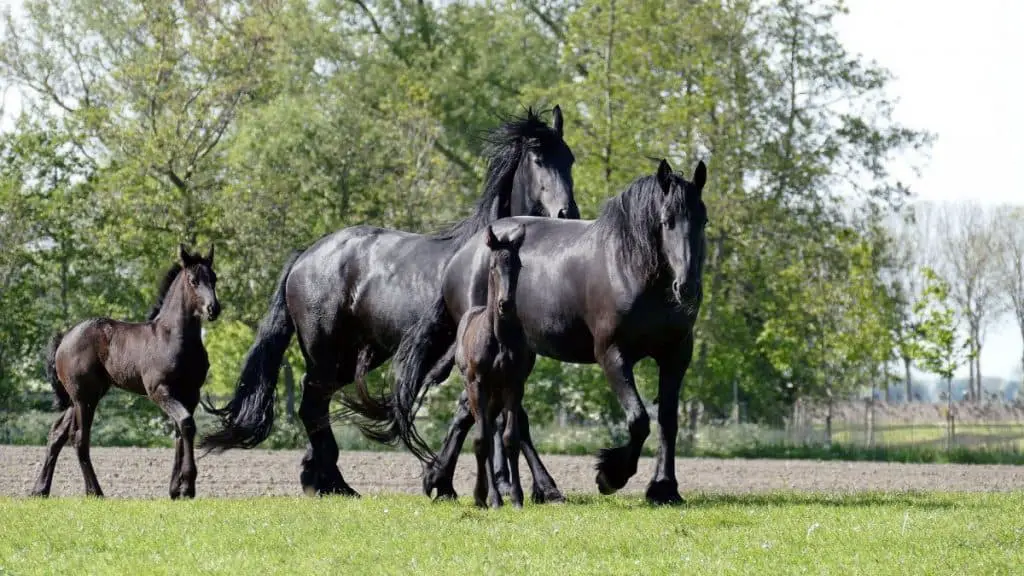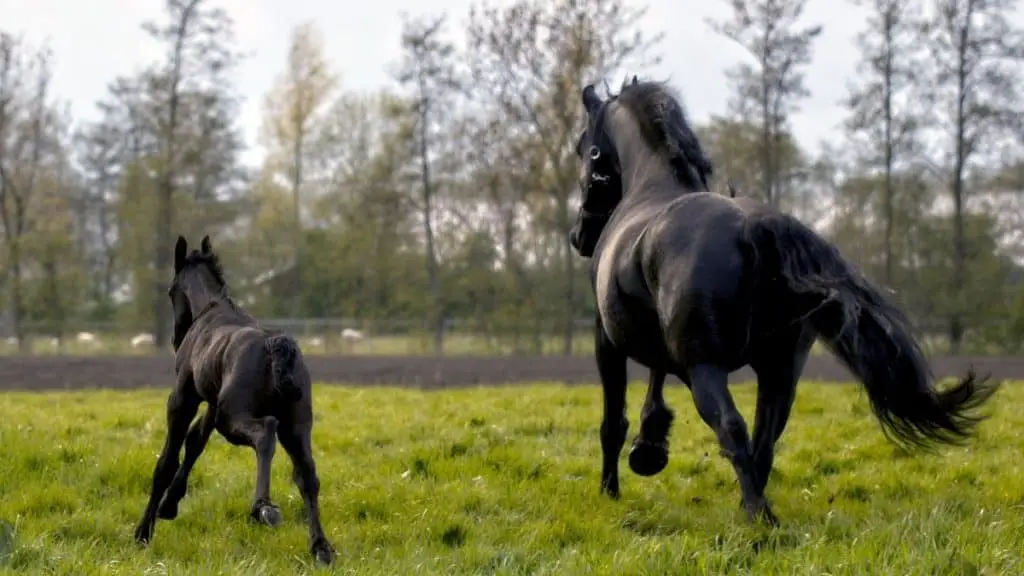Skip To Section
Friesians are a magnificent, rare breed of horse. Pedigree Friesians with special designations by the various accredited Friesian horse associations can cost between $20,000 and $50,000 or more. Friesians with no studbook designations, as well as younger or older horses, can cost as low as $6,000 or even $3,000. Many factors will decide the price range of this breed.
If you have ever had the opportunity to meet a Friesian in person, they are quite the sight to behold. Friesian horses are some of the most attractive and versatile horses available. From dressage to trail riding to pulling carriages, Friesians can do it all.

These facts, combined with the special accreditations Friesians require and its breed rarity, make them one of the more expensive horse varieties.
Let’s look at some of the details and find out how much Friesians cost and what factors play a role in determining their price.
How Much Is A Friesian Horse?
Like with all horse buying, Friesians’ purchase price depends on several factors, including the type of Friesian and its pedigree quality.
There is quite the range in cost when it comes to Friesians, and the factors we’ll discuss below all play a role. A pureblood Friesian yearling could cost you as low as $5,000. A pureblood stallion that has qualifying offspring could cost upwards of $600,000. But these prices are for horses that do not meet the Friesch Paarden Stamboek (FPS) breeding qualifications.
What Makes Friesians Special?
The Friesian is native to Friesland, Holland, a province in the northern Netherlands. It is one of the most ancient horses currently existing, with a history dating back to the 4th century CE to its introduction to the United States in 1970.
The breed has almost gone extinct several times throughout its history. Estimates vary, but many sources say that only three Fresian stallions were available for breeding by World War I, and in 1970 there were a mere five Friesian stallions left in the world.
However, these once-endangered beauties have slowly seen their population increase. The population of Friesians had risen to 800 by 1991, and today there are about 8000 living in North America alone.
Despite these increases, Friesians are still considered one of the rarest breeds in the world.
Friesians have only one recognized color: black. Three shades are recognized, and sometimes there is a star on the forehead. Before modern breeding practices turned them into an all-black horse, the Friesian was known to come in bay-family or grey colors.
Studbook registered Friesians are much costlier and qualify as pedigree Frisians only if they come in the following three shades of black:
- Very dark brown
- Black bay
- True black
The average Friesian stands at about 15 hands high (hh) and weighs an average of 590 kg (1,300 lbs). Compared to other horses, the Friesian has a lower life expectancy of about 16 years.
It’s not only their looks that attract people to this breed but also their behavior and temperament. They are known for being willing, loyal companions that are active and high energy but with a calm disposition.

Factors Affecting Cost
Several factors affect a Friesian’s cost, including its type, designation, registration, training, gender, and size.
Let’s go into some detail on each of these points.
1. Friesian Type
There are three main types of Friesian:
- Baroque
- Modern
- Sport
Baroque Friesians are more robust and have a thicker appearance, shorter legs, and more closely related to the original Friesian warhorses.
Modern Friesians are leaner, faster, lighter, and more graceful. These are most popular for drawing carriages and racing.
Sport Friesians are finer-boned, taller, leaner, and much more athletic. Often used as leisure riding horses, sport Friesians excel at dressage.
According to the Friesian Sport Horse Association, only Thoroughbreds, Warmbloods, Arabians, or American Saddlebreds can crossbreed with Friesians. At least 25% Friesian blood is required for registration with the Friesian Sport Horse Association.
Sport and modern Friesians are more expensive than the classic Baroque.
2. Designation And Registration
Friesians registered with the Friesian Horse Association of North America (FHANA) or the Friesch Paarden Stamboek (FPS) will have a higher cost due to these groups’ strict standards.
The FPS is the global authority on the Friesian pedigree. A Friesian that has had their pedigree certified by the KFPS will cost more than one that has not, as will a horse that has already received training.
The FPS will inspect a horse twice in its life, once when they are a foal and a second reevaluation when they reach adulthood. It is during this adulthood evaluation that a horse earns a ‘premium’ status. In this case, they gain entry into a Studbook, and the status is recorded on the registration certificate.
Horses with special studbook designations are far more expensive than those who have no designation.
3. Rarity
The fact that Friesians are among the rarest horses in the world makes them much more desirable. There are only an estimated 37,000 Friesians in the world, and as we saw above, they have been wrestled back from the cusp of extinction several times over the years. This adds to their value and price tag considerably.
4. Temperament
There are three horse character designations:
- Cold-blooded
- Warm-blooded
- Hot-blooded
Friesians sit in the happy middle. They are warm-blooded, which gives them the best of both temperaments. They are known to love people and have excellent athletic abilities.
5. Training
Price always factors in whether or not a horse has received training. A trained Friesian will cost more than an untrained Friesian, which is true of all horse breeds.
6. Color, Size, Age, And Gender
Stallions are more expensive than mares because of their place in the breeding chain. Older and younger horses are less costly than ones who are in their prime. If a Friesian is very inexpensive, it may indicate health issues such as a fatal genetic condition or an aortic artery rupture.
This is why accreditation is so important because it allows you to know the horse’s bloodline before buying. Knowledge of the parent’s health before purchasing will save you a lot of trouble as the horse matures.
Colour is something we have already discussed. Only horses in three acceptable shades of black can be registered. Potential buyers care a great deal about the aesthetic appearance of their horse. Color may change slightly depending on sun exposure and sweat.
Heritage Friesians (‘Fire Friesians’) are available for purchase, but these are not true Friesians and cannot be registered in an official studbook because they may possess a hybrid percentage. These ‘Fire Friesians’ are much less expensive than registered Friesians and can come in red or chestnut coat colors.
In terms of size, the FPS sets a standard size for Friesians, regardless of type. A horse that meets those standards will cost more than one that does not.
- Stallion sizes are standardized at 15.3 hands high (1.6 meters).
- Mare sizes are standardized at 14.3 hands high (1.5 meters).
The ideal size for both breeds is between 15.25 and 16 hh. Friesians that meet this ideal are frequently more expensive than ones that are either taller or shorter.
7. Upkeep Costs
The cost of keeping a Friesian is similar to that of any other horse. They require grasses, hays, grains, and supplements, depending on how much nutrition they are getting from foraging. Frisians, just like other horses, will also require regular vet and farrier visits.
Conclusion
Friesians are gorgeous animals that fully justify their higher price point. As we have seen, Friesian horse cost is affected by many factors, and some Friesians, particularly young or old ones, or hybrids such as Friesians crossed with quarter horses, can be relatively inexpensive. But there is nothing quite like a pureblood Frisian with all the accreditations required to make the studbooks.

